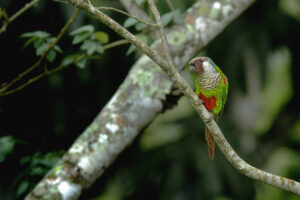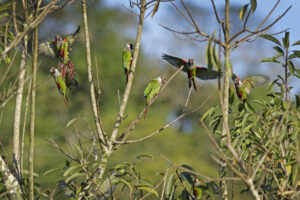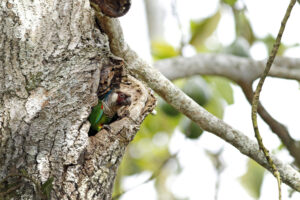
If you have been to Latin America, then you may know that smaller hookbills with long tails are commonly referred to as parakeets – birds we call conures in the U.S. The grey-breasted Parakeet (Pyrrhura griseipectus) was once widely found across northeastern Brazil but now is only found in five locations in the Brazilian state of Ceará. Reduction in its population is a result of the usual conservation challenges — the destruction of the humid mountain forest habitat, which has been reduced to about 13% of its original scope, along with illegal poaching for the pet trade.
In 2003, the Brazilian government recognized the grey-breasted parakeet as critically endangered. In 2007, the non-profit organization AQUASIS founded the Grey-breasted Parakeet Project. AQUASIS was formed by a group of university students in 1992. Its original focus was marine mammal life and conservation. Today, it is also dedicated to the conservation of birds as well as ecological education.

AQUASIS describes the plight of the Grey-Breasted Parakeet best, as found here on their website and reprinted here with their permission:
The Grey-breasted Parakeet is a social species and lives in family groups of approximately 4 to 15 individuals. This relatively small parakeet measures 22 to 28 cm in length, weighs an average of 5 grams, and eats a variety of fruits, seeds, and flowers. At dusk, they tend to congregate in tree hollows, or among palm leaves and bromeliads, as a means of protection from predators.
Grey-breasted Parakeets breed only once a year, from February to June, and females lay an average of 6 eggs. They nest in natural tree cavities, but as they are not able to excavate their own hollows entirely, they often take advantage of and augment holes created by woodpeckers. When new offspring are hatched, both parents share the task of feeding them. Sometimes a third member of the social group will also help with feeding, thereby supporting the parents in raising their offspring.
Main Threats
Capture of Grey-breasted Parakeets for the illegal pet trade is currently one of the main threats to the species because, in addition to reducing the number of wild individuals, this deplorable practice is responsible for the ongoing destruction of many of the rare, natural nesting cavities of the birds. Indeed, criminal pet traders and the demand of their buyers has resulted in the local extinction of this species from many locations where it is known to have occurred in the past.

Deforestation also remains a serious threat to the future of Grey-breasted Parakeets persisting in the wild, as it diminishes the availability of feeding areas and breeding locations, forcing the birds to wander and establish themselves in other locations that remain suitable for their needs.
Knowing the Grey-breasted Parakeet’s population size and understanding its trends over the years is fundamental to directing conservation efforts as the species still faces the possibility of becoming extinct. Supporting sites that are known territories and making artificial nest boxes available to the species is an essential function of the project and helps to collect more accurate life history data.
In 2022, a record number of 472 parakeets fledged from our nest boxes, and with the continuation of these efforts, the number is expected to keep increasing in the coming years. The artificial nest boxes that are installed and maintained by the project team are an extremely important conservation strategy for the Grey-breasted Parakeet. As the species reproduce only once a year, the availability of nests is essential for the reproductive process to occur normally.

Lafeber’s GLOBAL PARROT grant this month goes to AQUASIS to build additional nest boxes for the Grey-breasted Parakeets now breeding in northeast Brazil. If you would also like to help or learn more, go to: https://www.aquasis.org/?lang=en or https://abcbirds.org/news/gray-breasted-parakeet-reintroduction/ for more information.
